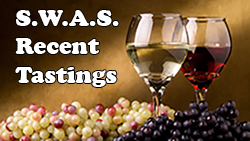Saturday 3rd September 2022: "Of beauty, rich and rare": A celebration of Australian Wine - with Christopher & Elizabeth in Worthing
Yet another very welcome delve into the dark corners of Christopher's extensive cellar...
List of Wines Tasted:

The Whites:
1.  2021 Astro Bunny Pet-Nat; Wildman Wines, South Australia; Zibabbo, Fiano, Arneis, Nero d’Avola, Mataro; 12% abv
2021 Astro Bunny Pet-Nat; Wildman Wines, South Australia; Zibabbo, Fiano, Arneis, Nero d’Avola, Mataro; 12% abv

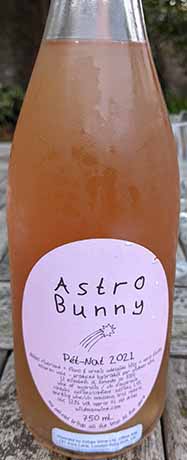
Despite the funky look of the bottle and the opaque, unfiltered wine inside, this is a beautifully pretty, clean, crisp and refreshing Australian fizz, made from zibbibo, fiano, arneis, nero d’avola and mataro, from Adelaide Hills and McLaren Vale vineyards. The nose offers peaches, mango, passion fruit, lemon and melon fruits, while the palate is foamy as opposed to overly fizzy, with fresh peach and apricot flavours and a moreish tang on the finish. A perfect apertitif and a wonderful alternative to an aperol spritz, drink well-chilled and gently turn the bottle upside down to mix in the fine sediment before opening, to enjoy this generously textured, crisp, complex and infinitely fun wine.
2.  2009 Grosset, Polish Hill Riesling; Clare Valley, South Australia; 100% Riesling; 13% abv
2009 Grosset, Polish Hill Riesling; Clare Valley, South Australia; 100% Riesling; 13% abv
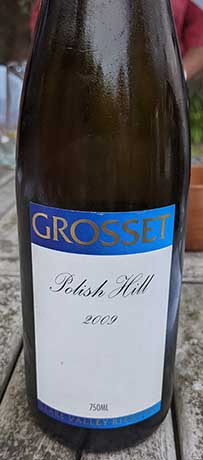
"I tasted this new vintage twice during my recent few days in Singapore and was particularly impressed. This magnificent single-vineyard bone-dry wine would make great current drinking or provide a real long-term classic for your cellar. Grosset's style of Riesling can be uncompromisingly austere in youth – so much so that I think an increasing number of fellow practitioners copy it too slavishly, to the detriment of their wines, leaving them almost painfully hard and fruitless, rather like the early German trocken wines but with more alcohol. But 2009 turned out to be a great vintage for the best producers of the world's greatest white wine grape in its Australian home, the Clare Valley.
There is much more fruit, juice and obvious ripeness in the Jeffrey Grosset, Polish Hill Riesling 2009 Clare Valley at this early stage than most years and, as Grosset himself points out on www.grosset.com.au, "the 2009 Polish Hill is a surprise packet with quite exuberant, lifted floral aromatics providing a departure from the norm. On the palate, there is a brightness and youthful tang that is rare in young Polish Hill Rieslings. As ever, there is intense, pristine lime juice flavour made more complex by slatey, minerally characters all compressed and coiled by the wine's tightness of structure. There's characteristic finesse, power and a steely quality before the taut natural acidity highlights its lingering, dry finish. While the 2009 Polish Hill should age as well as other vintages, it may provide more joy in its youth". He recommends drinking it now or cellaring it for six to 15 years, and certainly the longevity of past vintages from this very special site does nothing to dispel this optimistic prediction.
It is widely available and, rather gratifyingly for non-Australians, tends to cost more in Australia than abroad – as is the way with most Australian wines that are highly regarded. This wine for example is one of Matthew Jukes' 100 Best Australian wines 2010 – in fact I'm surprised that Grosset didn't make it into Jukes' Hall of Fame." - Unknown Critic's Notes
3.  2007 Mount Pleasant Lovedale Semillon; Hunter Valley, NSW; 100% Semillon; 11.5% abv
2007 Mount Pleasant Lovedale Semillon; Hunter Valley, NSW; 100% Semillon; 11.5% abv
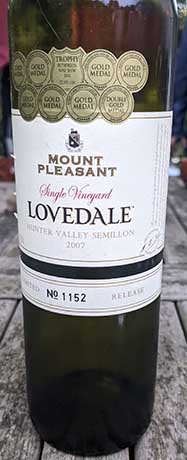
Planted in 1946, the highly prized Lovedale Vineyard is the source of the Mount Pleasant Lovedale Semillon, one of the region’s great wine styles. Early picked and cool vinified, the wine is tightly concentrated and austere with floral lemon curd aromatics, a core of sweet fruit and strong, assertive acid cut. Bottle ageing under screwcap enables the wine to develop into something special. The colour deepens to gold and toasty, lanolin characters develop as richness and flavour complexity emerge.
4a.  1947(?) Chateau Tahbilk Victorian Chablis Marsanne; Nagambie Lakes, Victoria; Marsanne; ? abv
1947(?) Chateau Tahbilk Victorian Chablis Marsanne; Nagambie Lakes, Victoria; Marsanne; ? abv
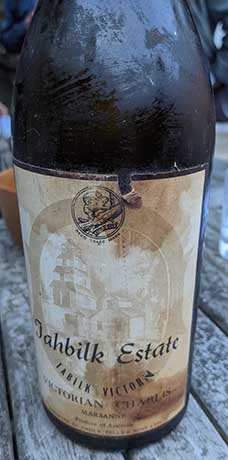
4b.  2015 Chateau Tahbilk 1927 Vines Marsanne; Nagambie Lakes, Victoria; Marsanne; 11% abv
2015 Chateau Tahbilk 1927 Vines Marsanne; Nagambie Lakes, Victoria; Marsanne; 11% abv
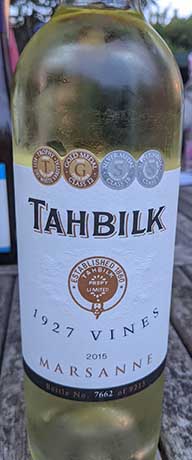
Tahbilk Marsanne is one of Australia’s few genuine, white wine legends. Remarkably, given that Marsanne is an important French grape variety, Tahbilk’s Marsanne plantings are said to be the oldest and largest in the world. Lemony-fresh, with hints of tropical fruit, when young, the unoaked wine ages well for at least 10 years and the best vintages for an additional two decades or more, developing complex, spicy, honeysuckle and marmalade-like characters. Tahbilk Marsanne has long been universally considered both under-rated and underpriced, yet the Purbrick family generously continues to make enough to keep insiders happy all over the world. Says Jeni Port, of The Age, Melbourne: ‘The Aussie Marsanne by which others are judged, this unwooded, bare-bones Rhône white grape gives the gentlest honeysuckle/jasmine touch. It’s beautifully understated and extremely drinkable, but built for age’.

The Reds:
5.  NV Rockford Sparkling Black Shiraz; Barossa Valley, S. Australia; Shiraz (disgorged March 2014); 13.8% abv
NV Rockford Sparkling Black Shiraz; Barossa Valley, S. Australia; Shiraz (disgorged March 2014); 13.8% abv
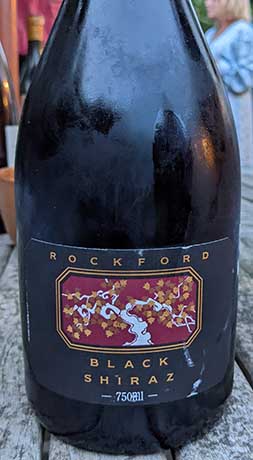
Rockford Wines is a wine producer based in Australia's iconic Barossa Valley. It was founded in the early 1980s by Robert O'Callaghan and is one of Australia's more well-known wineries, making top Shiraz and Cabernet Sauvignon wines.
O'Callaghan began as a trainee winemaker in 1965 at Seppelt in Rutherglen, Victoria. In 1971, he headed west to the Barossa and purchased two hectares (five acres) of land beneath the Barossa ranges.
He planted vines and built a winery in the style of the 1850's stone cottage on the land. Rockford's inaugural vintage was in 1984.
In addition to the small home vineyard, Rockford works in partnership with several independent wine growers around Barossa, with vineyards in Kalimna, Ebenezer, Moppa Springs, the Eden Valley and central Barossa. This gives Rockford a wide variety of soil types, mesoclimates and altitudes for its grapes.
Many of the vines are planted on their own rootstocks and range between 60-100 years old, giving intense, concentrated grapes which translates into the wines. Winemaking is largely traditional, using basket presses, open-topped concrete fermenters and a 1880s Bagshaw (grape) crusher which was found on site when O'Callaghan purchased the property in the 1970s.
Rockford's flagship wine is its Basket Press Shiraz, which is aged in French and American oak hogshead barrels for two years prior to release. It is one of Australia's more sought-after wines and has regularly achieved high scores from critics.
There are several other top wines in the portfolio, including the Rifle Range Cabernet Sauvignon, the Sparkling Black Shiraz and the Rod and Spur Cabernet – Shiraz blend.
6.  2002 Clonakilla Shiraz Viognier; Canberra District; Shiraz, Viognier; 14% abv
2002 Clonakilla Shiraz Viognier; Canberra District; Shiraz, Viognier; 14% abv
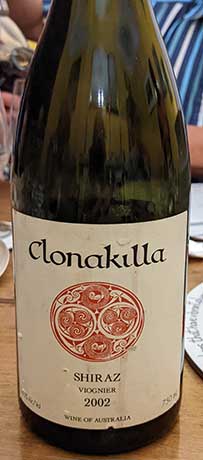
Clonakilla is an Australian winery, located in Murrumbateman of the Canberra wine region. It was founded by John Kirk in 1971, with the inaugural vintage in 1976 the first from the entire region.
Therefore, Clonakilla is best known for putting the Australian town of Canberra on the map as a wine producing region.The first plantings on the estate property were of Riesling, Sauvignon Blanc, Cabernet Sauvignon and Shiraz and, today, also include Viognier, Pinot Noir, Semillon and Chardonnay.
The flagship wine from Clonakilla is a blend of Shiraz and Viognier. The two grapes are co-fermented and the resulting wine is rich, deep and dark with notes of white pepper, black fruits and sweet white flowers. The grapes that produce this wine come from the finest plots in the Clonakilla Murrumbateman vineyards.
The Murrumbateman vineyard is also well suited to Riesling, as its granite soils and cool climate ripen the grape perfectly. In 2015, the 40th vintage of Clonakilla Riesling from the Murrumbateman vineyards was released.
The Canberra district, as part of the wider Southern New South Wales zone, has a relatively cool climate compared to much of the rest of Australia. Clonakilla's vineyards are divided into two sections: the elevated vineyards, which produce grapes with austerity and florality, and the vineyards on the plains, which produce fruit that is more powerful and concentrated. The diversity of these plots give Clonakilla a wide range of flavor characteristics to draw from.
Founder and Irish immigrant John Kirk moved to Canberra in 1971 and purchased a farm on 16 hectares (40 acres) of land and began to plant vineyards. Shiraz was first planted in 1972. It was traditionally blended with Cabernet Sauvignon, as was the fashion in Australia at the time. However, by 1990 it was found to be performing so well in the vineyards that the winemakers decided to bottle it separately. In 1992, after John Kirk's son had visited the Rhône Valley, the winemakers at Clonakilla decided to try and co-ferment Shiraz alongside Viognier. This proved to be a virtuous endeavor as the co-fermented wine is now the flagship from the label.
7.  2005 Cullen Diana Madeline; Margaret River, W. Australia; Cabernet Sauvignon, Merlot, Malbec, Cab Franc, Petit Verdot; 14% abv
2005 Cullen Diana Madeline; Margaret River, W. Australia; Cabernet Sauvignon, Merlot, Malbec, Cab Franc, Petit Verdot; 14% abv
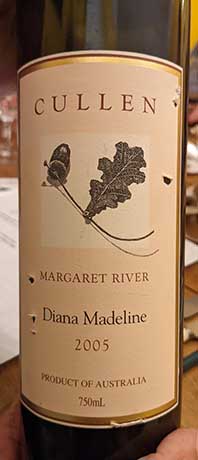
Critic's tasting note: "With only 50 cases imported, this review will be of only academic interest to most consumers, but for those lucky enough to latch onto a bottle or two, try to hold off opening one until 2015 or so. Right now, it's oh so promising, but also very tight. Scents of toasted almonds, vanilla and cassis only stubbornly emerge, and the wine is clearly packed with potential but also showing a lot of tannin on the finish." - 93/100, Wine Enthusiast
8.  2016 Yalumba ‘The Caley’; Coonawarra/Barossa, S. Australia; Cabernet Sauvignon, Shiraz; 14% abv
2016 Yalumba ‘The Caley’; Coonawarra/Barossa, S. Australia; Cabernet Sauvignon, Shiraz; 14% abv
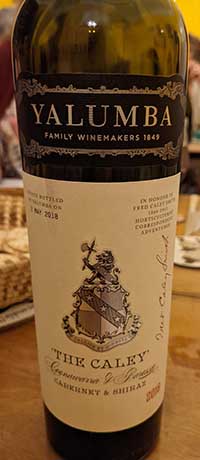
The Caley is the pinnacle of a long winemaking journey of excellence, that rightfully honours one of Yalumba’s most adventurous sons. A blend of Coonawarra Cabernet Sauvignon and Barossa Shiraz, The Caley is a classic marriage of two noble varieties and two great Australian wine regions.
Fred Caley Smith, the grandson of Yalumba founder Samuel Smith, was a horticulturist who had a profound impact on the development of Yalumba’s vineyards. In the early 1890’s he spent 18 months trekking across the USA, Britain, Europe, the Middle East, India and Sri Lanka, observing and reporting on scientific and horticultural developments. His detailed letters, sent home every few days, underpinned the way our vineyards were managed and laid the foundations of sustainable viticulture at Yalumba today.
The Caley has been sourced from three outstanding vineyards of the Coonawarra and Barossa regions. The Ming D block of the Yalumba Coonawarra vineyard provides 52% of the Cabernet Sauvignon of the blend. This 2.7ha plot was planted in 1992 with two clones of Cabernet Sauvignon selected for structure and depth of flavour. This block differs from the ubiquitous Coonawarra terroir, with a higher content of clay than the other blocks on The Menzies Estate. The Shiraz is sourced from the Burgemeister “Linke Block” between Nuriootpa and Angaston. Planted in 1901, these Shiraz vines run east-west and are on a single wire trellis. The soil is a red brown earth in the Light Pass loamy fine sand family. There is also a component that comes from the 1971 Yalumba Horseshoe Block in Eden Valley.
The Cabernet Sauvignon and Shiraz parcels were fermented separately in open fermenters. Indigenous or ‘wild’ yeasts, naturally present on the grape skins, initiated the fermentation to contribute complexity, richness and fine texture. Cultured winery yeasts were then added to complete fermentation. Gentle plunging and pulsing of the skins were undertaken to achieve the right balance of colour, tannin and phenolic extraction. The Caley was matured for 22 months in a mix of 31% new French barriques and hogsheads, 22% one-year-old French barriques and the balance in older French barriques and hogsheads. The barrels were all made and seasoned at the Yalumba Cooperage. After bottling, the wine was cellared for a further 36 months and released in 2017.
At the time of blending, the winemaking team made the following tasting notes ... Deep garnet red in colour, fruit is at the core of the bouquet, all red and black currants – overlaid with savoury herbs, green spices, cedar and pipe tobacco. The palate is of sophisticated precision with a refined line. Long and textured it captures the concentrated flavours and presents them with a silken grace. Under all that supple, fleshy muscle, the wine has a strong spine, structured to last and last.
Savour with a slow roasted rack of veal, rubbed with sea salt, rosemary and garlic, served with roast potatoes, carrots, parsnips and steamed green vegetables or chargrilled brussel sprouts with lotus root and sweet marinated tofu.
9.  1997 Penfolds Grange Hermitage; Barossa/McLaren Vale, S. Australia; Shiraz, Cabernet Sauvignon; 14% abv
1997 Penfolds Grange Hermitage; Barossa/McLaren Vale, S. Australia; Shiraz, Cabernet Sauvignon; 14% abv
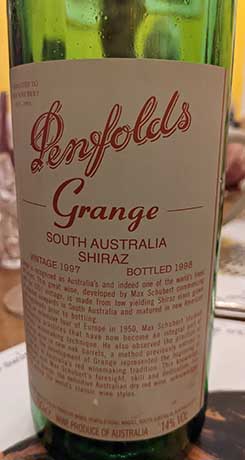
The 1997 vintage is made predominantly from Shiraz (96%) with a small amount of Cabernet Sauvignon (4%) added. A very refined Grange with great power and concentration but without the bulky palate weight. Very deep brick red colour. Magnificent nose with aroma of vanilla confectionery, violets and spice - almost perfumed. The palate flavours are very concentrated, with dark chocolate, spice, ripe plum, mocha & vanilla over a very peppery background. Outstanding length and depth. Fine firmish tannins, dry yet perfectly balanced. The aftertaste heralds a magnificent finish and lasts for several minutes with plum, mocha and liquorice evident.
Other Reviews...
The 1997 Grange (a blend of 96% Shiraz and 4% Cabernet Sauvignon) looks to be a classic Grange, although slightly softer and more forward than the backward 1996. The saturated purple-colored 1997 offers a gorgeously sweet nose of blackberry liqueur, cherries, camphor, chocolate, plums, and mocha. The wine is opulently-textured, extremely soft, layered, and seductive, with Grange's tell-tale personality well-displayed, but in a seamless, seductive style. This is a superb Grange that can hold its own against the more heralded 1996.
Anticipated maturity: 2005-2022.
(94 points Robert Parker - The Wine Advocate)
10.  1997 Henschke Hill of Grace; Eden Valley, South Australia; Shiraz; 14% abv
1997 Henschke Hill of Grace; Eden Valley, South Australia; Shiraz; 14% abv
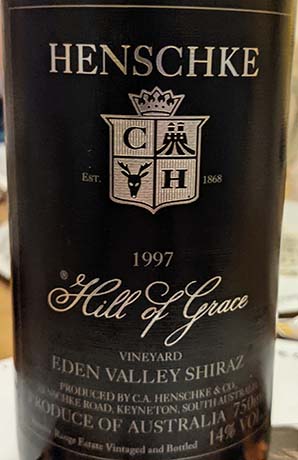
Producer tasting notes: "The 40th vintage maintains Henschke’s ‘Exceptional wines from outstanding vineyards’, and shows brick red colour with ruby hues. Enticing aromas of sweet, ripe red, and blue fruits, plum jam and leather are complemented by Hill of Grace’s familiar nuances of exotic five spice, herbs and chocolate. The palate is lush and juicy; intense and powerful layers of flavour, texture and acidity with fine, velvety tannins for a long, elegant finish." - Henschke

The Supper Menu: TBA
The Supper Wines:
11.  2007 d'Arenberg The Dead Arm; McLaren Vale, South Australia; 100% Shiraz; 14.5% abv; originally purchased for the SWAS Cellar for £27
2007 d'Arenberg The Dead Arm; McLaren Vale, South Australia; 100% Shiraz; 14.5% abv; originally purchased for the SWAS Cellar for £27
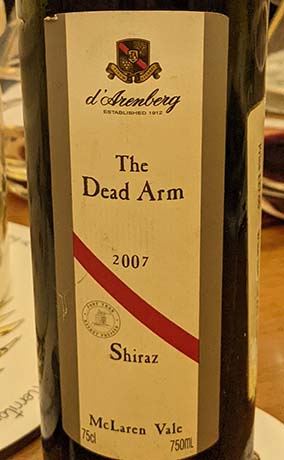
The Name:
Dead Arm is a vine disease caused by the fungus Eutypa Lata that randomly affects vineyards all over the world. Often vines affected are severely pruned or replanted. One half, or an ‘arm’ of the vine is slowly reduced to dead wood. That side may be lifeless and brittle, but the grapes on the other side, while low yielding, display amazing intensity.
The Vintage:
Due to drought conditions not seen for decades, 2007 was the earliest start to vintage in McLaren Vale. Overall winter rainfalls were a third of what is considered normal. The dry conditions and cold spring temperatures leading up to the growing season affected the vines fruiting and canopy development, with very short shoot length. This resulted in reduced bunch and berry size and ensured high tannins. Just as vintage was to commence McLaren Vale experienced 50mm of rain, which caused some problems with fruit splitting but essentially saved the vintage. The rain provided enough ground moisture in the final stages for the fruit to ripen in a stress free state. This resulted in grapes having concentrated flavours at lower levels of beaume ripeness with excellent levels of acidity. Yields were down approximately fifty percent for most of the premium dry grown vineyards that contribute to The Dead Arm Shiraz . This reduced yield is a contributing factor to the concentration of flavours and great tannin structure seen in 2007. Both factors that will aid in the longevity of this great Shiraz.
Cellaring Potential:
In youth The Dead Arm is restrained. It will start to show more fruit after five years in the bottle with secondary aged characters starting to develop after that. As an older wine leather, tobacco, mushroom and earth aromas have a presence alongside chocolate and spice characters. With such great balance this wine is expected to age for up to 20 years if cellared in the right conditions.
The Winemaking:
Walking the vineyard rows and tasting grapes, Chester Osborn classifies and determines the ideal picking time for each individual vineyard. Small batches are crushed in the Demoisy open-mouthed, rubber toothed crusher and then transferred to five-tonne headed-down open fermenters. These batches remain separate until final blending. Foot treading is undertaken two thirds of the way through fermentation. When tannin extraction is just right the wine is basket pressed and transferred to a mixture of new and used French and old American oak barriques to complete primary and secondary fermentation. The barrel ferments are aged on lees to keep the wine fresh while also reducing the oak influence. There is no racking until final blending. Chester and the winemaking team undertake an extensive barrel tasting process to determine the final blend. The Dead Arm Shiraz does not undertake fining or filtration prior to bottling.
Tasting Note:
The nose is very aromatic, floral and youthful. There is a fascinating amount of intensity that draws you back. The lavender floral notes along with plum and blackberries are the most pronounced while the enigmatic beauty of this wine lies in the next layer of extremely alluring pepper, cinnamon, nutmeg and hint of five spice. The opulent palate is rich and dense with staggering concentration. Crushed ants, rhubarb, and deep earth add to the complexity. The chewy tannins are abundant and balanced by the fruit power. Building through the palate the tannins provide for a long, vibrant, savoury and spicy finish. The Dead Arm Shiraz 2007 manages to balance focus and complexity superbly . The structure is muscular and the fruit powerful, yet it maintains a pretty elegance which is allowed to flourish with deft use of oak.
12.  NV Campbells Merchant Prince Rare Muscat; Rutherglen, South Australia; Muscat; 17.5%
NV Campbells Merchant Prince Rare Muscat; Rutherglen, South Australia; Muscat; 17.5%
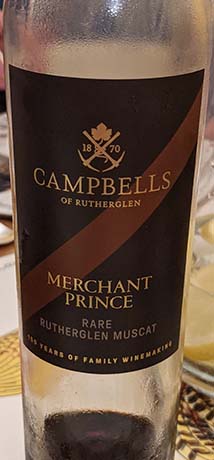

Several years ago, a voluntary classification of Rutherglen Muscats and Tokays was implemented. Each wine is classified in ascending order of quality with the average age stipulations for each descriptor graded as follows: for 'Rutherglen', two to five years old; for 'Classic', five to 12 years old; for 'Grand', 12 to 20 years old, and for 'Rare', 20 years or more. Naturally, there's an enormous difference in the concentration and complexity of wines distinguished by these grades - not to mention price. When compared with first growth Sauternes or a Pedro Ximenez Sherry of similar age, purchasing a bottle or two of these amazing fortifieds will seem less like blatant hedonism and more like carefully considered insurance against the chance of an extended winter.
The highly regarded 'Wine Spectator' magazine of New York recently awarded 100 points to Campbells Merchant Prince Rare Muscat.
The magazine has reviewed more than 11,000 Australian wines over the past 30 years, but this is the first time it has reviewed a 'perfect Australian wine'.
Other reviews... The Rare cuvée is pure nectar. My favorite of this quartet is the virtually perfect non-vintage Rare Muscat Merchant Prince. Its dark amber color is accompanied by an extraordinary perfume of toffee, caramels, prunes, and raisins with hints of maple syrup and soy. Although its viscosity is reminiscent of motor oil, the wine is not cloyingly sweet because of good underlying acidity as well as surprising tannin that frames this enormously endowed, sweet elixir. This stunning offering is one of Australia’s treasures. Justifiably renowned for their tremendous dessert wines, Campbell’s four cuvees all performed impressively well, making one wonder if the price difference between the regular and rare offerings is really worth it. Certainly there is a bit more complexity and intensity to the Rare Tokay and Rare Muscat, which emerge from a solera system averaging 60 years of age. In any event, the tasting notes for all four wines are nearly identical to any of the great Australian fortifieds, such as Buller, Chambers Rosewood, etc
Wine Advocate #148 (Aug 2003) Robert Parker: 99 points
13.  David Franz AD 1979 VP; Barossa/Langorne Creek, S. Australia; Shiraz, Cabernet Sauvignon; 17.4% abv
David Franz AD 1979 VP; Barossa/Langorne Creek, S. Australia; Shiraz, Cabernet Sauvignon; 17.4% abv

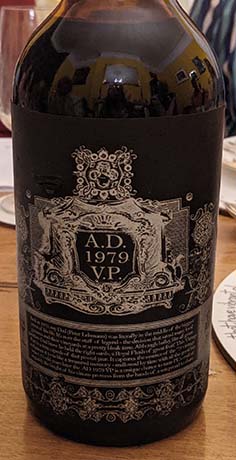
The tag 'legend' is all too often bandied around these days. The actions of Peter Lehmann on hearing that, then employer, Saltram would not honour "my word is my bond" contracts to fruit growers are now the stuff of legend, nigh folklore and cemented that man's reputation into the fabric of the Barossa. Legend.
What many may not know, is that on leaving Saltram, Lehmann the elder snuck a bit of 'Port' he made from a combination of Barossa Shiraz and Langorne Creek Cabernet into his leaving package. It was kindly re-released for him by son David, under his own label. Too kind.
Complex: gorgeous nutty complexity, dark toffee in the mix, molasses and a touch of aniseed. There are layers of history on the palate. Oh, the stories this wine could tell. The palate is enhanced with an aniseed/ fennel note that is carried by a spirited edge.
The final third just has staying power, treacly notes course through the finish. Tough to judge, yet it's balanced has good length, the passage of time has been kind. History cannot be bought.


